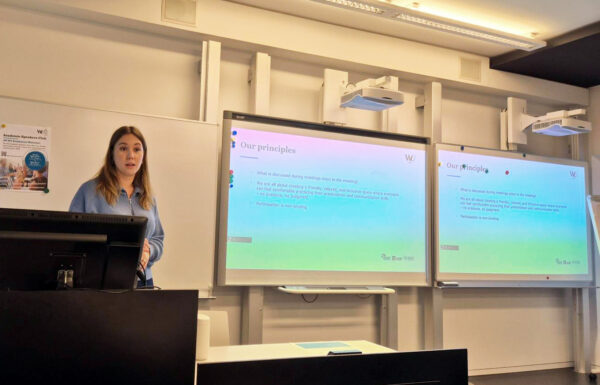Team of the month 09/20: The Teams Team
Wednesday, March 11, 2020 – 2 days before the start of the lockdown: Students have already become familiar with distance learning, and it is becoming clear that most employees will soon be working from home. On this Wednesday afternoon, preparations were started for the comprehensive, WU-wide launch of a video conferencing application. At this point in time, no one even knew it would be Microsoft Teams. So, who’s the Team behind Teams? The Teams team: Stefan Benzinger, Christoph Weber, and Thomas Birthelmer (IT-SERVICES, Server Infrastructure division), Michael Klein and Hakan Siretoglu (IT-SERVICES, Client Infrastructure division), Barbara Zimmer and Victoria Khuon (IT-SERVICES, Support Center), Kenan Selak (Legal Affairs Office), and many more – from members of the staff councils to the office of the Vice-Rector for Academic Programs and Student Affairs.
A hurried comparison of the available options was initiated. Aside from Teams, products like Adobe Connect and Skype for Business were under consideration, as well as tools not currently in use at WU like Zoom, WebEx, and various open-source applications. During a night shift, the various options were evaluated based on comprehensive background information. Aspects covered in the deliberations included user friendliness, legal factors, data security, and ease of integration into the existing IT infrastructure.
From the very beginning, different units at WU had to work closely together on this issue. The roll-out of Teams never would have been possible without the input of the Legal Affairs Office, a risk assessment provided by the Chief Information Security Officer, and contributions on teaching requirements.
The final details were cleared up by Friday and the decision was made to go with Microsoft Teams.
By the time the new tool went live on Monday, March 16, 2020, all WU employees had access to a Microsoft Teams account, the software was ready for installation, instruction manuals and support services were provided by the office of the Vice-Rector for Academic Programs and Student Affairs, teachers were notified, and the support team was ready to address the most frequently asked questions. Concurrently, talks were ongoing with both staff councils to allow the introduction of Microsoft Teams in advance of a corresponding operational agreement, given the exceptional circumstances. By the end of June 2020, after a series of highly constructive negotiations with the staff councils and with the support of the Legal Affairs Office, the final piece of the puzzle in the form of an operational agreement was slotted into place.
An indispensable part of day-to-day work
“We never could have imagined the tool would have over 2,500 simultaneous users,” says Stefan Benzinger, head of the IT-SERVICES division responsible for Teams. After just a few days, Teams had become an indispensable part of work and a valuable tool for communication and cooperation at WU.
Today, Teams is used for informal communication, for organizing working groups and video conferences with external stakeholders, in research and teaching, and in many other workplace settings.
Roll-out in record time
“Based on our 2019 strategy planning, we knew that WU needed a modern solution allowing employees to work together independent of time and location,” says Josef Kolbitsch, CIO of WU. “This was often requested in our talks with the faculty and the service units.”
So this field of action was not only included in the WU Digitalization Strategy, IT-SERVICES had already been looking into the challenges and stumbling blocks associated with a potential introduction of this type of tool in the fall of 2019. That gave the team a good head start in March 2020 and made it possible to implement the entire roll-out in just a few days.
What do we have to look forward to?
Competition is currently fierce on the video and collaboration tool market, especially between Zoom and Microsoft, which is spurring on the continued development and regular improvement of these products. The hand-raising feature, the ability to show up to 49 meeting participants, and the fun auditorium view in Together Mode are just 3 of the newest innovations in Teams.
IT-SERVICES is working continuously to implement the features users need and to improve the application. Currently, for example, the team is looking into how the telephone system and Teams can be integrated to allow users to make and accept landline calls using the Teams interface.
Team of the Month
Research and teaching are the key areas of a university’s work, and the most visible. However, the work of the administrative staff is also very important for making sure that a university can operate smoothly and successfully. The members of our administrative staff may not be as highly visible as our researchers, but it’s their commitment that provides our researchers and teaching staff with crucial services like a powerful IT infrastructure, state-of-the-art library services, effective support services for faculty and researchers, tailor-made in-house training programs, or personal support in running the day-to-day operations of an institute – all of this requires careful planning and organization. To bring some of these people into the spotlight, we are naming a Team of the Month 6 times a year to introduce selected members of the administrative personnel and reward them for their important achievements in specific projects.


























